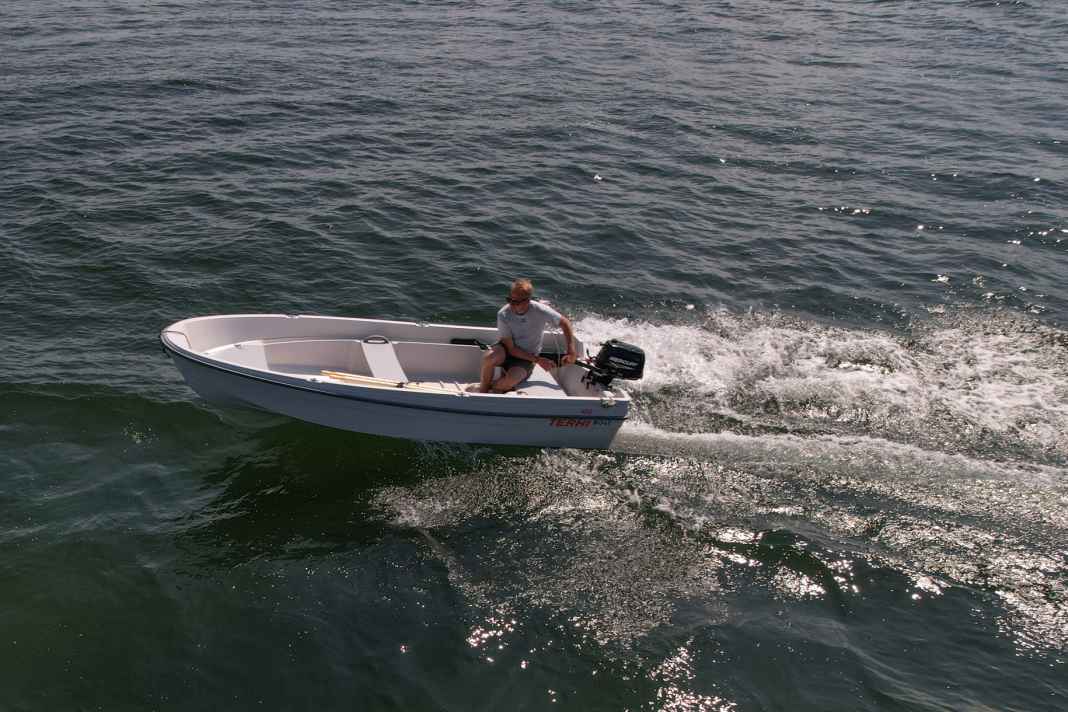





It's been a long time since we tested outboard motors. Back then, my colleague Erich Bogadtke was testing 5 hp outboard motor. In this test, the big brothers, the 6 hp engines, are put to the test. Five well-known manufacturers took part in the test on Lake Schwerin. Honda, Mercury, Tohatsu, Yamaha and Suzuki all put themselves to the test in various exciting comparisons. Small outboards are popular for inflatable or rigid hull boats. They are well suited for boat lengths between three and five metres.
Structure of the test
Our test is structured as follows: Two people ride a Terhi 400. The two people are always the same and, together with the test material for recording speed, consumption and volume as well as ten litres of fuel, weigh around 230 kilograms. According to the manufacturer, the boat weighs around 120 kilograms. The manufacturers send their specialists to set up the engines correctly and select the propellers. This is how we ensure that everyone has exactly the propeller and mounting height they want.
Different categories in the outboard motor test
But now to the actual test and its results. One category is cubic capacity. The leader is Yamaha with 139 cc, closely followed by Suzuki with 138 cc. Honda is at 127 cc, Mercury and Tohatsu at 123 cc. Anyone who has anchored in a bay knows that the noise level of an outboard motor can sometimes be enormous. Some of you will be pleased that we were only able to test four-stroke engines, which are generally quieter than the old two-strokes. These have fallen victim to emissions regulations. However, if you have to lift the engines, you will notice the extra weight of a four-stroke engine. But more about that in the next category. We have set ourselves a comfort noise limit of 85 dB(A). Three engines are above this at full throttle. Only Suzuki and Honda are lower at 84 dB(A). The Yamaha is the loudest at 88 dB(A).
Now to the weight. The engines are not much different here. The Suzuki, the Mercury and also the Tohatsu weigh 25 kilograms. Honda and Yamaha weigh around two kilos more. We took the values from the manufacturers. To find out how much thrust the individual engines have, we set up a bollard pull test. The boat is attached to a dolphin with a line and a bollard. A pull scale is attached in between to display the value. In this test, Mercury came last with 59 kilonewtons. The identical engine from Tohatsu achieved 61 kilonewtons, sharing second place with Yamaha and Honda. Only Suzuki achieved a slightly higher value.
Consumption and price are also important. In terms of consumption, they are all quite close to each other, it's just a question of decimal places. In the speed range between four and eight kilometres per hour, all engines consume less than one litre per hour. At eight kilometres per hour, Mercury has the lowest consumption. The identical engine from Tohatsu at six kilometres per hour. But even at ten kilometres per hour and full throttle, the race is decided between the two brothers. The Mercury can travel 83 kilometres on a ten-litre tank. The Suzuki brings up the rear with 62 kilometres.
Now to the price: The outboards are all between 1821 and 2089 euros. The Tohatsu is the most expensive. The Mercury is the cheapest, but this does not mean it is of poorer quality, at 1821 euros. All manufacturers offer a warranty of three or five years. In some cases, the warranty can be extended by two years by making an additional purchase or registering the engine.
The outboards at a glance
Honda (1999 Euro)
Honda sends its BF 6 AH into the outboard race. It is the only motor with a charging coil fitted as standard. It delivers 6 amps at 12 volts with a cut-off voltage of 14.48 volts. However, at 27 kilograms, it is almost 2 kilograms heavier than some other motors. The GRP bonnet conceals 127 cubic centimetres. Honda has found space here for spare splints. Under full load, we achieve a noise level of 84 dB(A). This means it shares first place in the test with Suzuki. On Lake Schwerin, we reached a top speed of 14.5 kilometres per hour at 5750 revolutions per minute. In terms of bollard pull, we achieved a value of 61 kilonewtons, putting us in second place together with Yamaha and Tohatsu.
Like all single cylinders in our test, it is started manually. An emergency start is possible with an additional rope. This is included in the scope of delivery. Starting is of course only possible when the clutch is disengaged. When reverse gear is engaged, the automatic reverse lock is activated. It is low-vibration when idling and when travelling. In this engine, the petrol-air mixture is prepared via a carburettor. This is equipped with an intake silencer. The built-in tank holds 1.5 litres and is made of plastic. The fuel is cleaned via a paper filter. This can be removed for maintenance work using the on-board tool. The operating instructions are written in various languages.
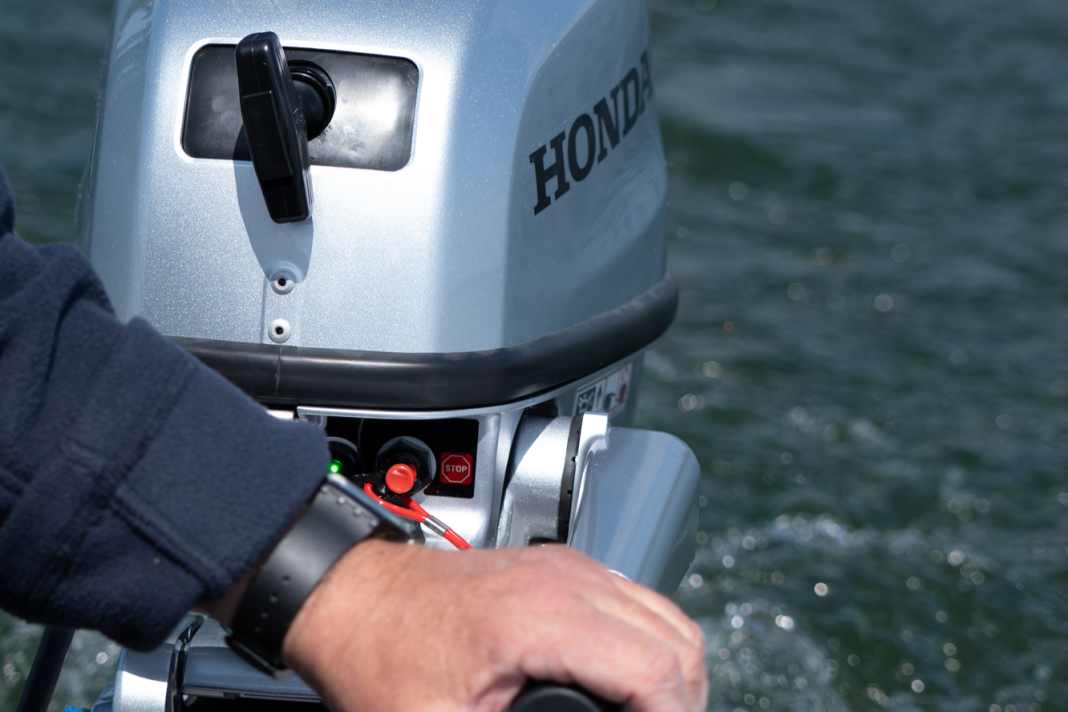





Technical data
- Manufacturer: Honda
- Type: BF 6 AH SHU
- Design: Four-stroke petrol engine
- Cylinder: 1
- Bore x stroke: 60.0 x 45.0 mm
- cubic capacity: 127 cc
- Performance: 4.4 kW (6 hp)
- Full load speed range: 5000-6000 rpm
- Weight (brochure/ready to drive): 27 kg
- Recommended fuel: at least 91 RON
- fuel system: Carburettor
- Ignition: electronic
- Cooling: Water/single circle
- Generator: 6 A as standard
- Recommended mirror height: 434 mm
- Gear ratio: 2,08 : 1
- Gear shift: Manual F-N-R
- Test propeller: 3 x 7 1/4" x 5.5"
- Manufacturer's warranty: 3 years
- Price: 1999 Euro
- Dealer proof: www.honda.de
Valuation
- + Processing
- + simple operation
- + Spare split pins in the lid
- + charging coil
- - slightly heavier
Mercury (1821 Euro)
The Mercury MH 6 has a displacement of 123 cubic centimetres, the same as the Tohatsu. This is because both engines are identical in construction. Only the engine cowling looks different. The single cylinder weighs 25 kilograms and naturally runs on petrol. The mixture is also prepared by a carburettor. With the three-bladed 7.8" x 8" propeller selected by the manufacturer, we were able to get our four-metre-long test Terhi up to a maximum of 15.4 kilometres per hour. With a fuel consumption of just under 1.9 litres per hour. The built-in tank has a capacity of one litre.
A reverse lock is automatically activated when the forward gear is engaged. The gear shift and throttle grip are smooth-running. As with all the motors tested, the friction of the throttle grip can be adjusted with a screw. This makes it possible to customise it to your own preferences. The quick stop is located in the centre of the housing.
he engine is started manually using a starter rope. In our test, the engine started reliably on the first or second pull. When it is running, we measured around 72 dB(A) at 6 kilometres per hour one metre away from the engine. Under full load, it is already 85 dB(A). The plastic bonnet fits well. As is usual in this class, it is not lined with sound insulation. Maintenance instructions are located in the bonnet. The manual comprises 56 pages. It is clearly written and illustrated.
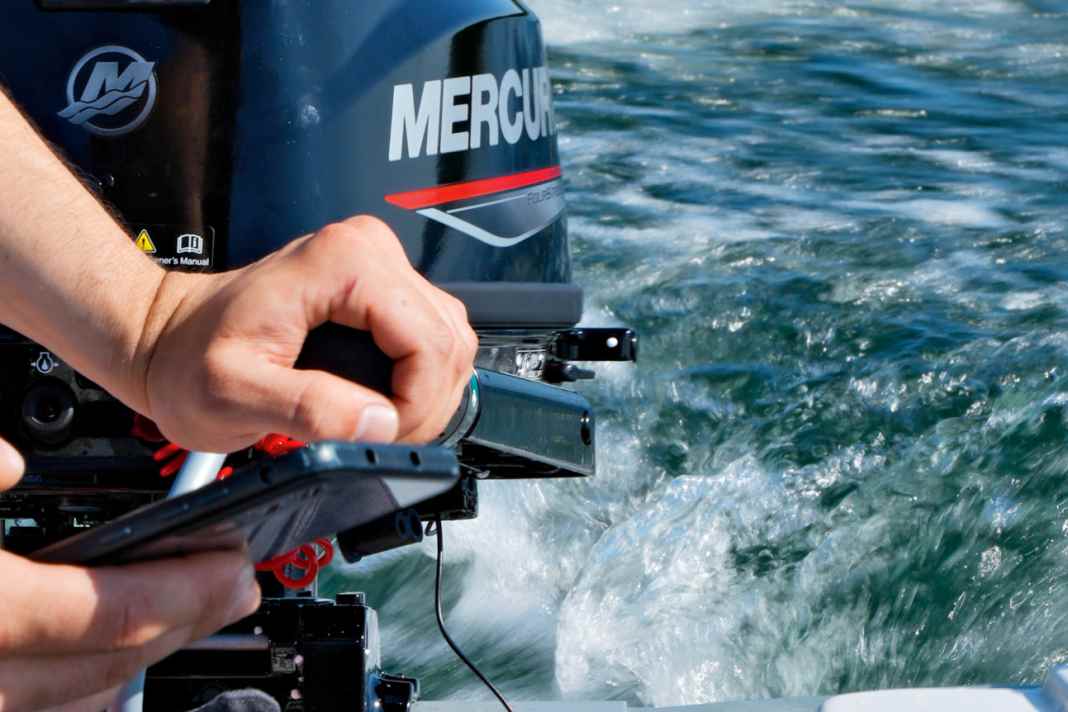





Technical data
- Manufacturer: Mercury
- Type: MH 6
- Design: Four-stroke petrol engine
- Cylinder: 1
- Bore x stroke: 59.0 x 45.0 mm
- cubic capacity: 123 cc
- Performance: 4.4 kW (6 hp)
- Full load speed range: 5000-6000 rpm
- Weight (brochure/ready to drive): 25 kg
- Recommended fuel: at least 91 RON
- fuel system: Carburettor
- Ignition: electronic
- Cooling: Seawater
- Generator: 4 A optional
- Recommended mirror height: 381 mm
- Gear ratio: 2,15 : 1
- Gear shift: Manual F-N-R
- Test propeller: 3 x 7.8" x 8"
- Manufacturer's warranty: 5 years
- Price: 1821 Euro
- Dealer proof: www.mercury.de
Valuation
- + Gear lever easy to reach
- + 92 cm starter rope
- + Anti-theft device on tommy screws
- - Slightly lower bollard pull
Suzuki (1890 Euro)
With an engine capacity of 138 cc, the Suzuki DF 6 AS plays in the upper league. With a weight of around 25 kilograms, it is well in the middle of the weight range. It is mounted on the mirror with tommy screws.
The engine is easy to operate. Starting is only possible when the clutch is disengaged. The gearstick is mounted on the side. It works well and without much resistance. At full throttle, we reach a top speed of 13.1 kilometres per hour with two people. The engine consumes 2.11 litres per hour. In the bollard pull measurement, the Suzuki achieved a peak value of 62 kilonewtons. This value makes it the most powerful in the test. The bonnet closes well and is held in place by two latches. It is made of plastic and is not insulated. In practice, the engine runs quietly and with little vibration when stationary. The starting behaviour when cold is good.
The mixture is prepared by a carburettor, which is supplied with fuel either from an additional tank or from the internal 1-litre tank. The fuel is cleaned by a cartridge petrol filter and can be changed using on-board tools. Spare splines for the propeller are supplied, but do not have a fixed position on the engine. A shallow water position is also available, as are five trim options. There is an automatic reverse lock when reverse gear is engaged. Suzuki offers a three-year warranty on the engine. When an engine is purchased from a dealer, it is automatically registered and the warranty is therefore extended.
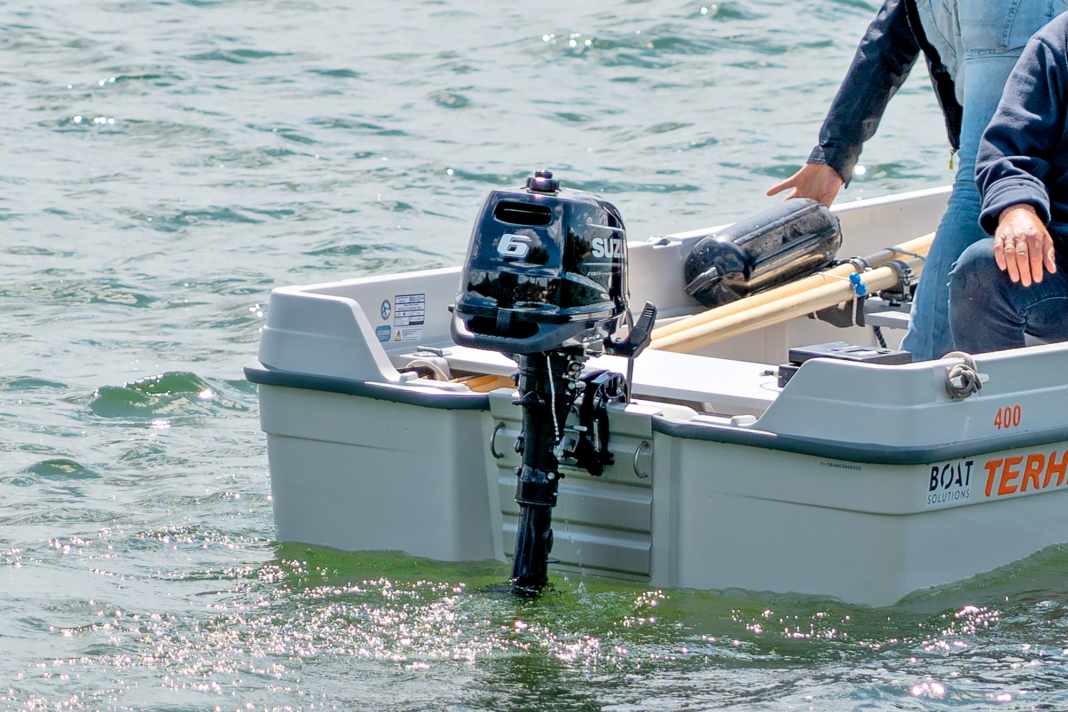





Technical data
- Manufacturer: Suzuki
- Type: DF 6 AS
- Design: Four-stroke petrol engine
- Cylinder: 1
- Bore x stroke: 60.4 x 48.0 mm
- cubic capacity: 138 cc
- Performance: 4.4 kW (6 hp)
- Full load speed range: 4750-5750 rpm
- Weight (brochure/ready to drive): 25 kg
- Recommended fuel: at least 91 RON
- fuel system: Carburettor
- Ignition: electronic
- Cooling: Water/single circle
- Generator: 5 A optional
- Recommended mirror height: 381 mm
- Gear ratio: 1,92 : 1
- Gear shift: Manual F-N-R
- Test propeller: 3 x 7 1/2" x 6"
- Manufacturer's warranty: 3 years
- Price: 1890 Euro
- Dealer proof: www.marine.suzuki.de
Valuation
- + highest kilonewtons in the tensile test
- + Quietest motor at full load
- + low vibration
- - slightly slower
Tohatsu (2089 Euro)
The Tohatsu MFS 6 is basically the same engine as the Mercury. Both come off the same production line. When buying, you can choose between white and black. The tiller can be folded upwards by 135 degrees. The gear lever is located on the side and is easy to reach. A connection for remote control of the motor is possible. The motor is trimmed by hand using a pin. Six positions and a shallow water position are available. It is not possible to start the engine when a gear is engaged.
The full-load speed of the Tohatsu is between 5000 and 6000 rpm. 5140 rpm was reached in our test with the selected propeller. This puts the full throttle speed at the lower limit. However, we still reach the top value for top speed. At 15.7 kilometres per hour, it is the fastest outboard in the test.
Under full load, the MFS 6 consumes 2.01 litres per hour. This is slightly higher than that of its brother, the Mercury. The noise level is 87 dB(A), measured one metre away from the engine. When stationary, the MF 6 runs quietly and with little vibration. The cold start behaviour is good. The mixture is prepared by a carburettor, which in our model can only be fed from an additional tank. However, it is also available with an internal tank. According to Tohatsu, the engine can be laid on three sides without oil leaking out of the engine.
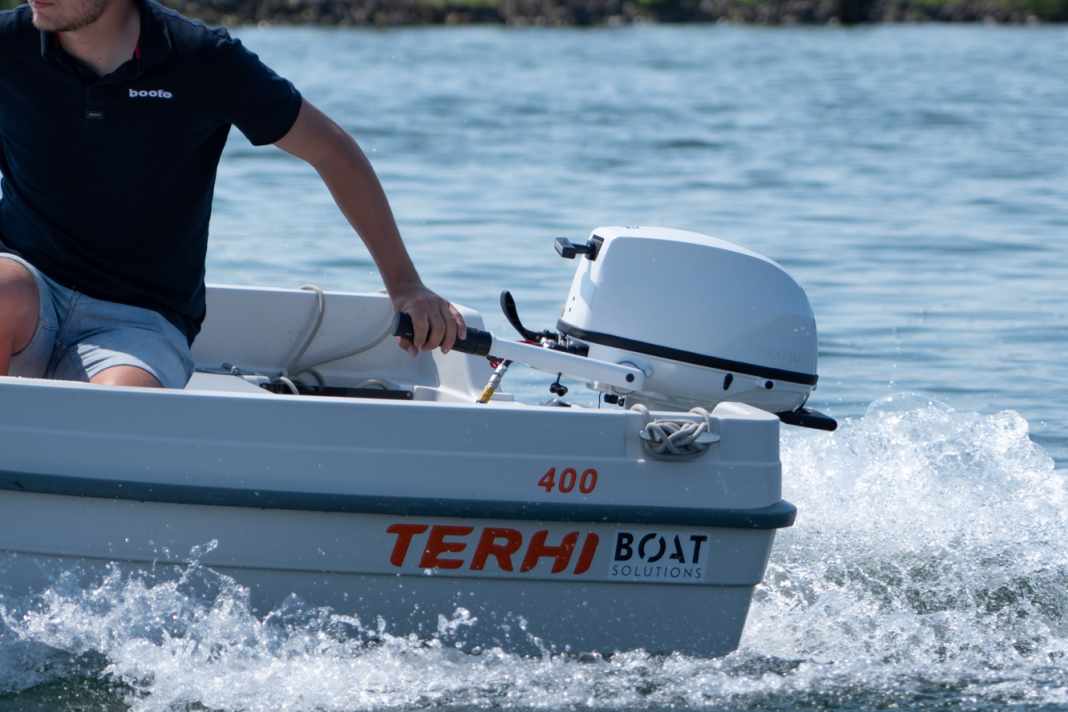





Technical data
- Manufacturer: Tohatsu
- Type: MFS 6
- Design: Four-stroke petrol engine
- Cylinder: 1
- Bore x stroke: 59.0 x 45.0 mm
- cubic capacity: 123 cc
- Performance: 4.4 kW (6 hp)
- Full load speed range: 5000-6000 rpm
- Weight (brochure/ready to drive): 25.60 kg
- Recommended fuel: at least 91 RON
- fuel system: Carburettor
- Ignition: electronic
- Cooling: Water/single circle
- Generator: 5 A optional
- Recommended mirror height: 381 mm
- Gear ratio: 2,15 : 1
- Gear shift: Manual F-N-R
- Test propeller: 3 x 7.8" x 8"
- Manufacturer's warranty: 5 years
- Price: 2089 Euro
- Dealer proof: www.tohatsu.de
Valuation
- + Shelf life
- + 5 year guarantee
- + lowest consumption
- - the most expensive in the test
Yamaha (1985 Euro)
Yamaha brings along the F6C for our test. With a displacement of 139 cubic centimetres, it is at the top of our quintet. However, at 88 dB(A) under full load, it is also the loudest. But the bollard pull measurement shows that it doesn't just roar. Here it achieves a value of 61 kilonewtons and shares second place with Honda and Tohatsu.
In the fuel consumption measurements, it is in the good midfield. It accelerates our Terhi 400 with two people to a maximum speed of 14.2 kilometres per hour. It is secured to the transom with two tommy screws. These screws and a padlock can be used to secure the outboard motor against theft. The engine can only be started without a gear engaged. The response behaviour and throttle response are good. The throttle grip can be adjusted using a screw on the tiller. The handlebar is 33.5 cm long. It sits comfortably in the hand in both wet and dry conditions and can be folded by around 85 degrees. A backstop is automatically engaged.
The outboard motor can be trimmed manually. Five options are available for this. A shallow water position is also available. At six kilometres per hour, the engine runs at 73 dB(A) and without major vibrations. The mixture is prepared by a carburettor, which is supplied with fuel either from an additional tank or from the internal 1.5-litre tank. The operating instructions are multilingual and illustrated. Yamaha offers a three-year manufacturer's warranty.
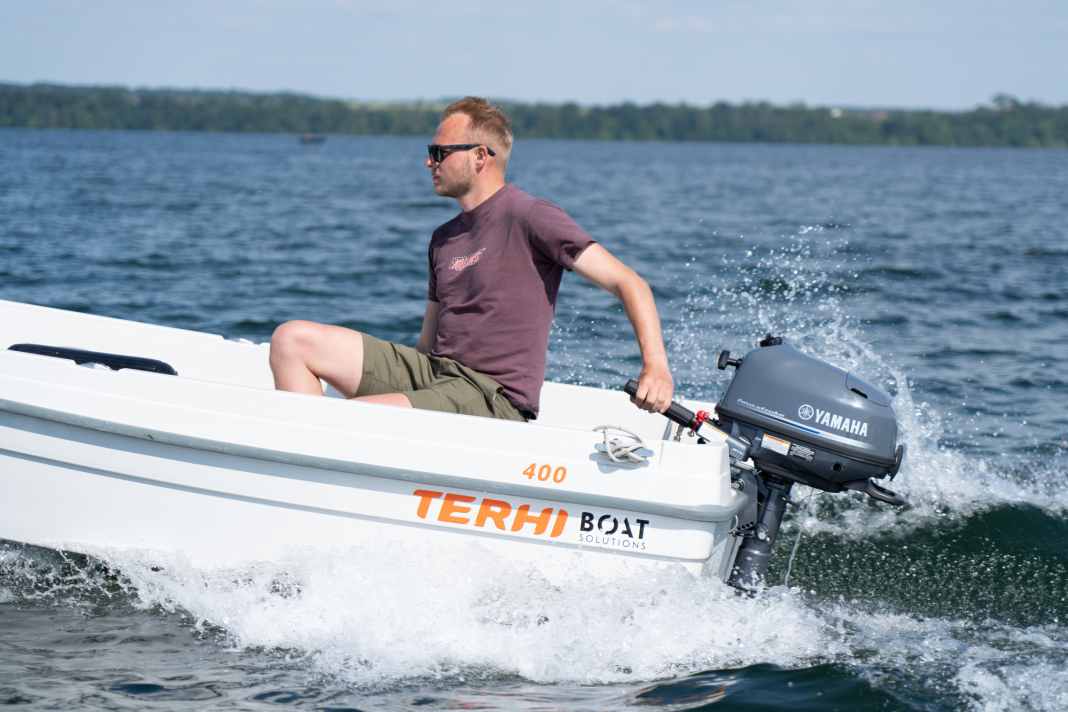





Technical data
- Manufacturer: Yamaha
- Type: F6C
- Design: Four-stroke petrol engine
- Cylinder: 1
- Bore x stroke: 62.0 x 45.0 mm
- cubic capacity: 139 cc
- Performance: 4.4 kW (6 hp)
- Full load speed range: 4500-5500 rpm
- Weight (brochure/ready to drive): 27 kg
- Recommended fuel: at least 91 RON
- fuel system: Carburettor
- Ignition: electronic
- Cooling: Water/single circle
- Generator: 6 A optional
- Recommended mirror height: 435 mm
- Gear ratio: 2,08 : 1
- Gear shift: Manual F-N-R
- Test propeller: 3 x 7 1/4" x 8 1/4"
- Manufacturer's warranty: 3 years
- Price: 1985 Euro
- Dealer proof: www.yamaha-motor.eu
Valuation
- + largest cubic capacity
- + simple operation
- + low vibrations
- - slightly heavier
Conclusion to the outboard motor test
If you look at the bare figures, the winner is not so clear-cut. Mercury and Tohatsu win the race in terms of fuel consumption. In terms of weight, noise and bollard pull, the Suzuki DF 6 AS comes out on top and can add these points to its account.
The Mercury MH 6 is the price-performance winner with 1821 euros and four out of ten points, but ultimately the serviceability is also a point that should not be scoffed at. If the nearest service workshop is far away, it may make sense to look around for another brand and thus save travelling costs and time.

